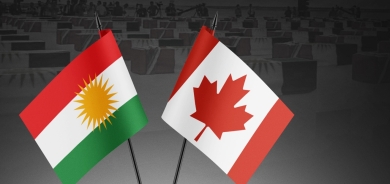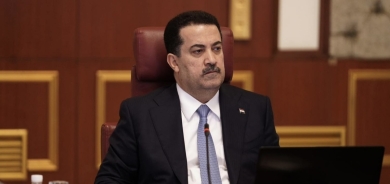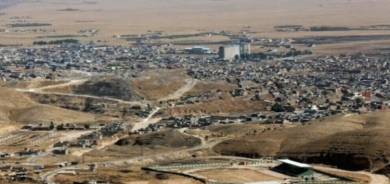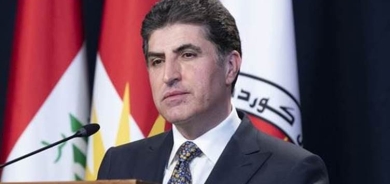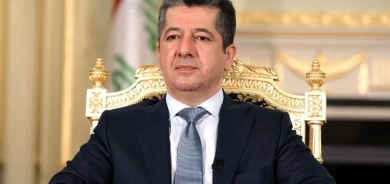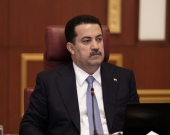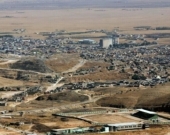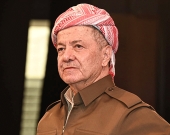Getting to Know the Yezidi Kurds of the Caucasus
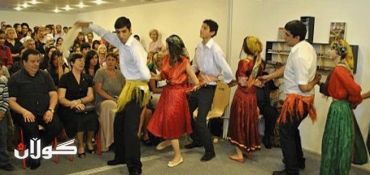
PARIS, France—“I advise you not to go there,” Wezire Iso told me after welcoming me at his office in Brussels, unable to understand my intended pursuit of the faded Kurdish culture of the Yezidis of the Caucasus.
To him, Georgia’s cosmopolitan capital Tbilisi, once a centre of Soviet Kurdish culture -- as well as Yerevan and the villages of the Aparan region in Armenia where he was born -- had become ghost towns where the Kurdish soul had disappeared forever.
This time-and-space exilen from the now lost world of the Soviet Kurds, sat before me behind a desk cluttered with newspapers and books, from where he ran the Kurdish Bureau, described by him as an independent cultural centre in Europe’s capital.
I could understand the bitterness of this venerable man, who belongs to a largely forgotten branch of the Kurdish nation that thrived in the southern Caucasus starting in the 19th century.
This community was mostly composed of Yezidi Kurds from Turkey who found themselves trapped behind the sealed borders of the USSR, following recurring Ottoman persecutions and mass exodus from their Anatolian homeland during World War I.
Behind the Iron Curtain they were cut off and isolated from their other brethren, who remained scattered across all of post-Ottoman Kurdistan. But under Moscow’s rule, the Kurds of Armenia and Georgia were recognized as a “nationality” and entitled to their own schools, language and culture.
Like fellow Soviet Kurds of his time, Iso learned Kurdish from textbooks supplied by the state and government-sponsored Kurdish literature, theater and publications.
As a writer and journalist for the Kurdish newspaper Rya Taze and as a speaker at the Kurdish edition of Radio Yerevan, Iso was a key agent of this vibrant cultural life.
But things changed fast with the collapse of the USSR and the emergence of the independent republics of Armenia and Georgia in the early 1990s.
The rise of nationalism
“The years that followed the independence of Georgia were very hard ones,” Pir Dima, a writer and scholar at the Sarhad Yezidi cultural centre, told me in Tbilisi.
“The prevailing state of mind in these troubled times was that Georgia should belong to Georgians only. The other components of the population were seen as strangers in their own land by the new authorities,” he explained.
With the rise of nationalism in Georgia and Armenia, the economic situation in both deteriorated. Kurdish intellectual life faded, together with state interest and support for Kurdish culture.
In response to the harsh economic conditions and chronic violence of the Caucasus, many from the Kurdish communities in Armenia and Georgia fled to Russia and Germany. But with this exodus there also began a large process of assimilation.
The Georgian and Armenian identities are essentially tied to their respective national churches. Caucasus Kurds -- who are mainly Yezidi -- were incited to change religions in order to blend with the dominant population.
“It quickly became difficult to find a job or to access basic public services when you were a member of a religious minority,” a Yezidi woman told me in Yerevan.
“Our people are sometimes compelled to hide their identity or to convert to Christianity in order to improve their standards of living” she said, speaking of an ongoing and exacerbating trend.
“We are threatened with self-oblivion,” lamented Pir Dima, “People are forgetting their history, their culture, their religion.”
In response, Dima’s Sarhad center tries to ignite a cultural revival among the Yezidi community of Tbilisi, with courses in culture, religion and language. On land granted by the municipality of Tbilisi, construction of a proper center with a library and projection room is in the works; plans include the first Yezidi temple ever built in Georgia.
Tying in with other members of the Yezidi diaspora is also an essential part of reviving the community, according to Pir Dima.
With the help of the Internet and easier travel regulations, Yezidis from Georgia and Armenia can now connect both with their kin and their religious authorities in Kurdistan.
Soon after the collapse of the Soviet Union, Pir Dima travelled to the Kurdish regions of Syria in order to meet fellow Yezidis, and participated in an official Caucasus delegation to Iraqi Kurdistan.
They met with the Kurdistan Region’s President Massoud Barzani and went for the first time to Lalish, the Yezidi sanctuary. This was a historical step for this once isolated community. For now, mass pilgrimage from Tbilisi or Yerevan to Lalish is limited by visa-related issues. Still, people manage to travel there every now and again.
But more and more, Caucasian Yezidis -- be they in Armenia, Georgia, Russia or Germany -- now refuse to regard themselves as Kurds.
In their interactions with the mainly Christian Georgian and Armenian societies, many Yezidis try to not be perceived as Kurds. For instance, when the young members of the Sarhad center went on stage during a party organized by the Tbilisi city council, they insisted on being referred to as a “Yezidi folk group,” not as a Kurdish one. Ironically they danced to Sivan Perwer’s famous “Delale.”
A large portion of the community’s representatives belong to the so-called Ezdiki movement, whose aim is to forge a new ethnic identity that is based on the Yezidi faith but is distinct from the Kurds as a whole.
According to Ezdikis, nationality equals religion and being a Kurd equals being a Muslim. They often emphasize the historical sufferings of Yezidis at the hands of Muslim Kurds. Some radical organizations within the Ezdiki movement even accuse “Kurdish nationalists” of the gruesome 2007 bombings and killings that targeted Yezidis in the Mosul region.
This quest for a brand new ethnic identity can reach extremes: The proponents of the Ezdiki movement claim, for instance, that they do not speak Kurdish but a hypothetical “Ezdiki language.”
When I greeted one of my hosts in Tbilisi with a few Kurdish words, he looked startled. “Oh you speak Ezdiki!” he said, speaking in a way that would have been perfectly understandable in Van or in Diyarbakir. However, he regarded Kurmanji as a foreign language and refused to call it his own.
“Serbian and Croatian were one language before Yugoslavia split” an Ezdiki activist told me. “It is the same for us. Creating a distinct language out of Kurmanji is just a matter of political will!” he insisted.
On social networks, a few followers of the Ezdiki movement even go as far as claiming a so-called “Ezidistan” that would stretch from Sinjar to Amedi.
The burden of war and identity politics
“This (Ezdiki) disease started here in Armenia in the beginning of the war against Azerbaijan and then spread to Georgia,” said Emerike Sardar, author of a dozen books as well as a legend of the Kurdish golden age under communist rule.
Sardar, a Yezidi by birth who regards himself as a secular Kurdish nationalist, is an old friend of Iso and was editor-in-chief of Rya Taze. His voice on Radio Yerevan reached as far as Turkey, at a time when satellite TV did not exist and uttering a single word of Kurdish in public could get you in big and painful trouble with Turkish authorities.
A forgotten hero of the Kurdish cultural resistance, Sardar now lives with his wife and daughter on a $200 pension, in an age where everything he believes in has been lost.
When the war sparked between Armenia and Azerbaijan in 1992 over the Karabagh issue, the already sour relations between Christian Armenians and Muslims reached a point of no return in both countries. Armenia’s Muslims started to pour into Azerbaijan, as its long-settled Armenian communities fled to Yerevan.
The Muslim Kurds -- a minority within the mainly Yezidi Kurdish community-- identified with the Muslim Azeris, intermarriage between these two communities being common. They therefore had to leave their homes and settled in Azerbaijan. There, Muslim Kurds blended with the dominant Turkish-speaking population. Today, they do not claim to be Kurds anymore.
“Some people here denounced the Muslim villagers to the Armenian authorities during the war” a resident of the Rya Taze village told me. All Muslim inhabitants of this Yezidi locality of the Aparan region, North-West of Erevan, left in the 1990’s.
“We have had our own ‘jash’ here in Armenia,” Sardar said. During and after the war, Yezidis had to prove their loyalty to the Armenian state by stressing their non-Muslim identity. This gave way to the Ezdiki movement, whose followers quickly got the upper hand on secular nationalists such as Sardar and Iso, with the support of the authorities.
“The Armenian government somehow helped the development of the movement. The authorities opened an Ezdiki language chair at the University of Yerevan as well as Ezdiki desks in public radio and TV that are distinct from the Kurdish ones” according to Estelle Amy de la Breteque, a French researcher specialized in Armenian Yezidi folk music.
As the war raged between Armenia and Azerbaijan, the generational takeover translated into violent actions.
“I was advocating Yezidi Kurdishness at Radio Yerevan. Suddenly, the studio was stormed by a group of rogue looters. They hit my head several times,” Iso recalled sadly. “I knew everything was over and decided to leave to Europe for my own sake.”
During the same period, Sardar received repeated anonymous death threats against him and his family.
Now, the situation is more nuanced at the individual, grassroots level.
“I know we are not a different nation” Ahmad, the Rya Taze village chief, told me. “Honestly, most people do not really care for this debate. War and the collapse of the Soviet Union changed everything in our lives. People of my age know they’re Kurds. The younger reject this fact. At the end of the day what difference does it make anyway?”
Despite the extremist speeches and statements, numerous people manage to step back from the current fierce debate.
In Elagaiz -- another village of the Aparan region -- people are more sympathetic with the Kurdish struggle. The Kurdistan Workers’ Party (PKK) opened an office there and honors the memory of Yezidi martyrs from Armenia who died in the mountains of Kurdistan.
“We must be proud of both our religion and of our nationality, which are two separate concepts,” said Seko, a Moscow resident on vacation in his native Yezidi village of Chamiram.
RUDAW

